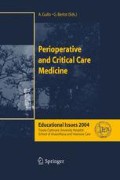Abstract
Intraventricular delay, especially left bundle branch block (LBBB), is present in up to 20% of patients with heart failure due to left ventricular (LV) dysfunction and can be considered a marker of disease. Although LBBB has been always considered a consequence rather than a cause of LV impairment, the delayed movement of the lateral wall towards the interventricular septum leads to a waste of energy and a reduced efficacy of LV contraction.
Access this chapter
Tax calculation will be finalised at checkout
Purchases are for personal use only
Preview
Unable to display preview. Download preview PDF.
References
Mower MM (1990) Preliminary animal studies on biventricular pacing. Clin Res 38:822A
Stellbrink C, Breithardt OA, Franke A et al (2001) PATH-CHF (PAcing THerapies in Congestive Heart Failure) Investigators; CPI Guidant Congestive Heart Failure Research Group: Impact of cardiac resynchronization therapy using hemodynamically optimized pacing on left ventricular remodeling in patients with congestive heart failure and ventricular conduction disturbances. J Am Coll Cardiol 38:1957–1965
Cazeau S, Leclercq C, Lavergne T et al (2001) for the Multisite Stimulation in Cardiomyopathy. Effects of multisite biventricular pacing in patients with heart failure and intraventricular conduction delay. N Engl J Med 12:873–880
Abraham W, Fisher WG, Smith AL et al (2001) The Multicenter InSync Randomised ClinicaL Evaluation (MIRACLE)—results of a double blind controlled trial to assess resynchronisation therapy in heart failure patients. J Am Coll Cardiol 38:604–605
Bristow MR, Saxon LA et al (2004) Cardiac-resynchronization therapy with or without an implantable defibrillator in advanced chronic heart failure. N Engl J Med 350:2140–2150
Ukkonen H, Beanlands RSB, Burwash IG et al (2003) Effect of Cardiac Resynchronization on Myocardial Efficiency and Regional Oxidative Metabolism. Circulation 107:28–31
Kono T, Sabbah HN, Stein PD et al (1991) Left ventricular shape as a determinant of functional mitral regurgitation in patients with severe heart failure secondary to either coronary artery disease or idiopathic dilated cardiomyopathy. Am J Cardiol 68:355–359
Breithardt OA, Sinha AM, Schwammenthal E et al (2003) Acute Effects of Cardiac Resynchronization Therapy on Functional Mitral Regurgitation in Advanced Systolic Heart Failure. J Am Coll Cardiol 41:765–770
Nelson GS, Berger RD, Fetics BJ et al (2000) Left ventricular or biventricular pacing improves cardiac function at diminished energy cost in patients with dilated cardiomyopathy and left bundle branch block. Circulation 102:3053–3059
Hamdan MH, Zagrodzky JD, Joglar JA et al (2000) Biventricular Pacing Decreases Sympathetic Activity Compared With Right Ventricular Pacing in Patients With Depressed Ejection Fraction. Circulation 102:1027–1032
Reuter S, Garrigue S, Barolo SS et al (2002) Comparison of Characteristics in Responders Versus Nonresponders With Biventricular Pacing for Drug-Resistant Congestive Heart Failure. Am J Cardiol 89:346–350
Sutton MGJ, Plappert T, Abraham WT et al for the Multicenter InSync Randomized Clinical Evaluation (MIRACLE) Study Group (2003) Effect of Cardiac Resynchronization Therapy on Left Ventricular Size and Function in Chronic Heart Failure. Circulation 107:1985–1990
Gasparini M, Mantica M, Galimberti P et al (2003) Beneficial effects of biventricular pacing in patients with a “narrow” QRS. PACE 26:169–174
Pitzalis MV, Iacovello M, Romito R et al (2002) Cardiac resynchronization therapy tailored by echo cardiographie evaluation of ventricular asynchrony. J Am Coll Cardiol 9:1615–1622
Søgaard P, Egeblad H, Kim WY et al (2002) Tissue Doppler Imaging Predicts Improved Systolic Performance and Reversed Left Ventricular Remodeling During Long-Term Cardiac Resynchronization Therapy. J Am Coll Cardiol 40:723–730
Cleland JGF, Daubert JC, Erdmann E et al (2001) The CARE-HF study: rationale, design and end-points. Eur J Heart Fail 3:481–489
Garrigue S, Reuter S, Labeque JN et al (2001) Usefulness of biventricular pacing in patients with congestive heart failure and right bundle branch block. Am J Cardiol 88:1436–1441
Linde C, Leclercq C, Rex S et al (2002) Long-Term Benefits of Biventricular Pacing in Congestive Heart Failure: Results from the MUltisite STimulation in cardiomyopathy (MUSTIC) study. J Am Coll Cardiol 40:111–118
Leon AR, Greenberg JM, Kanuru N et al (2002) Cardiac Resynchronization in Patients With Congestive Heart Failure and Chronic Atrial Fibrillation. Effect of Upgrading to Biventricular Pacing After Chronic Right Ventricular Pacing. J Am Coll Cardiol 39:1258–1263
ACC/AHA/NASPE (2002) Guideline Update for Implantation of Cardiac Pacemakers and Antiarrhythmia Devices: Summary Article Circulation 106:2145–2161
Leclercq C, Cazeau S et al (2000) A pilot experience with permanent biventricular pacing to treat advanced heart failure. Am Heart J 140:862–870
Gras D, Mabo P, Tang T et al (1998) Multisite pacing as a supplemental treatment of congestive heart failure: preliminary results of the Medtronic Inc. InSync Study Pacing Clin Electrophysiol 21:2249–2255
Leclercq C, Kass DA (2002) Retiming the failing heart: principles and current clinical status of cardiac resynchronization. J Am Coll Cardiol 39:194–201
Editor information
Editors and Affiliations
Rights and permissions
Copyright information
© 2004 Springer-Verlag Italia
About this chapter
Cite this chapter
Zecchin, M., Sinagra, G. (2004). Debate on Cardiac Resynchronisation Therapy. In: Gullo, A., Berlot, G., Lucangelo, U., Pellis, T. (eds) Perioperative and Critical Care Medicine. Springer, Milano. https://doi.org/10.1007/978-88-470-2135-8_15
Download citation
DOI: https://doi.org/10.1007/978-88-470-2135-8_15
Publisher Name: Springer, Milano
Print ISBN: 978-88-470-0278-4
Online ISBN: 978-88-470-2135-8
eBook Packages: Springer Book Archive

